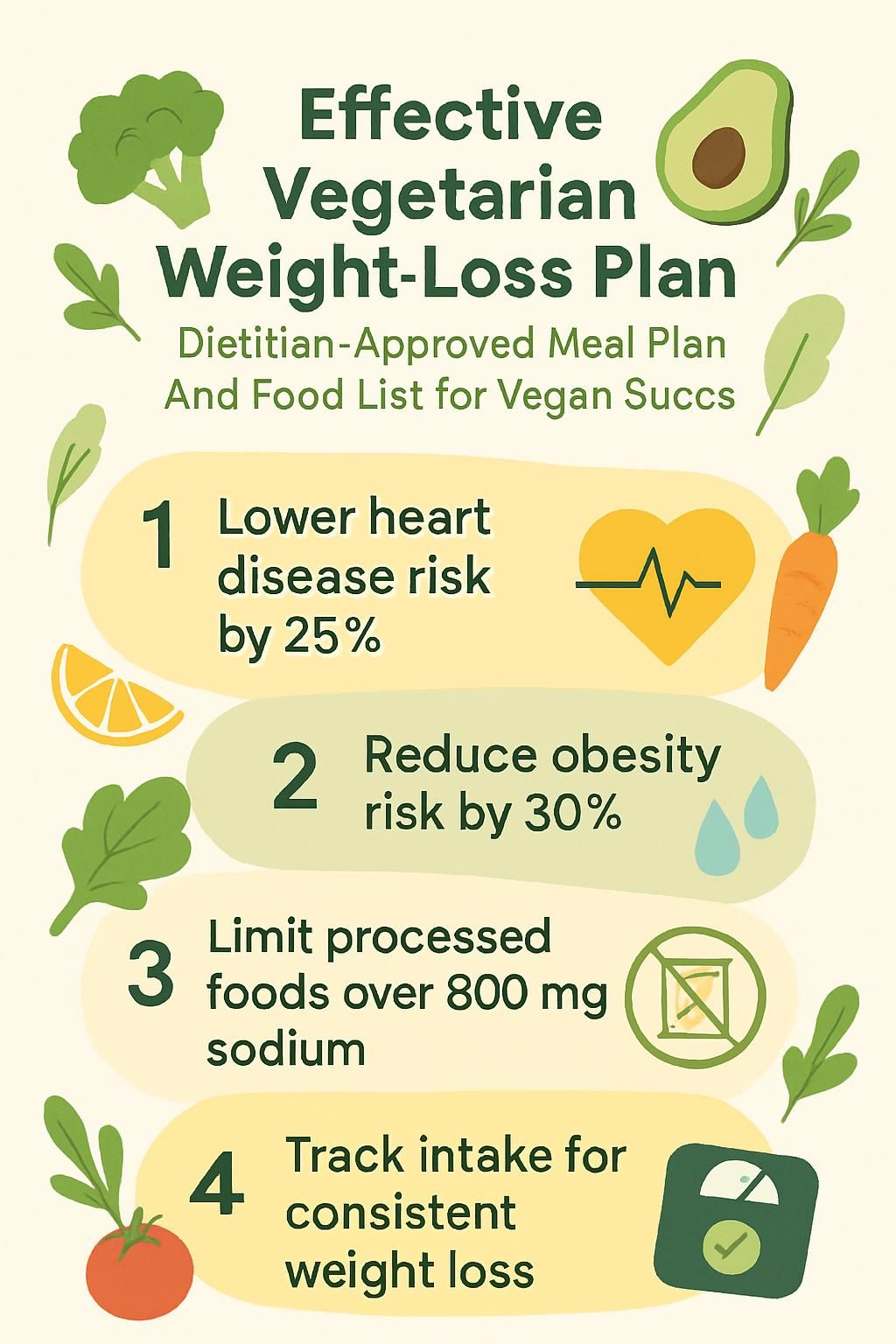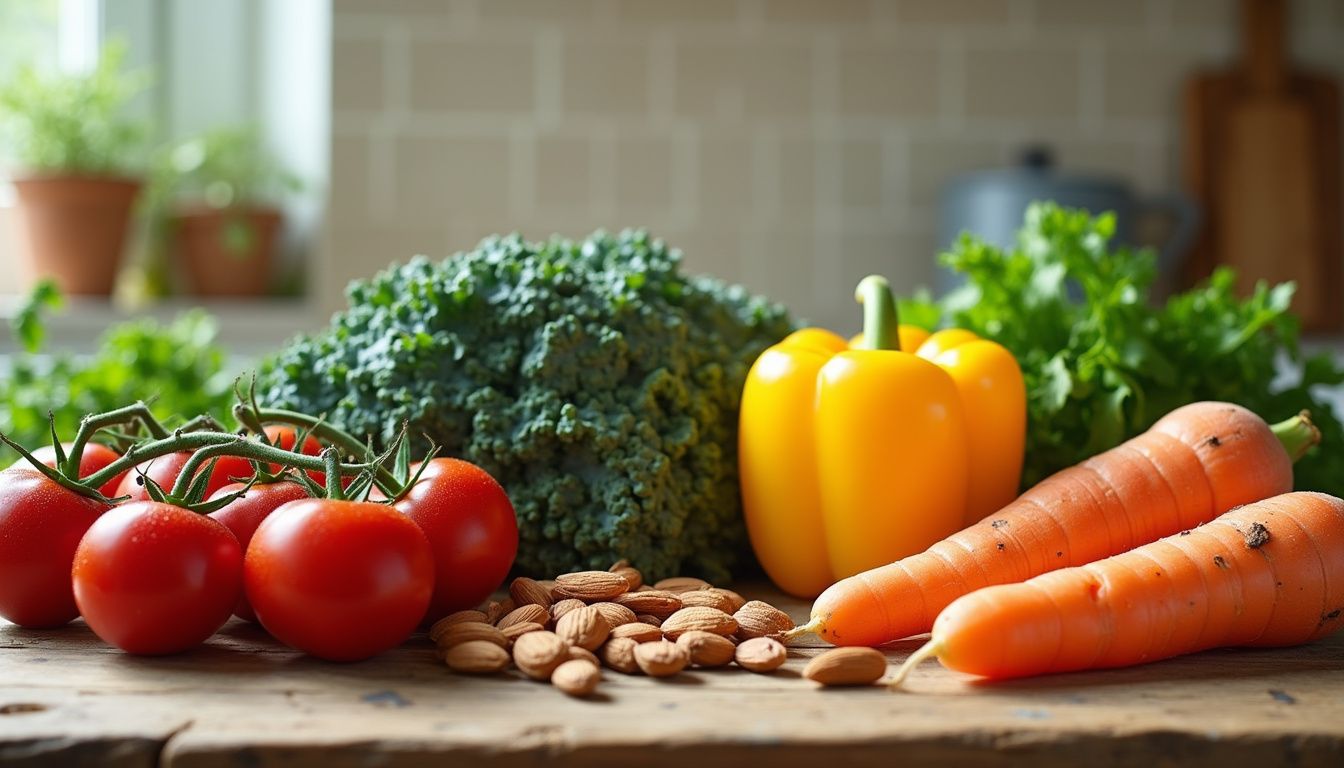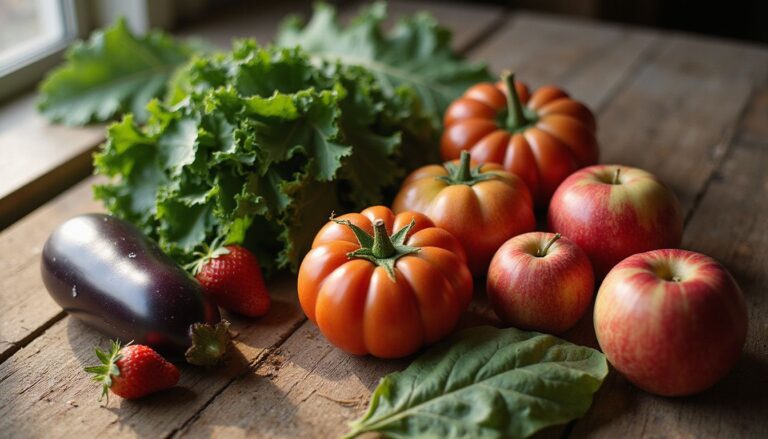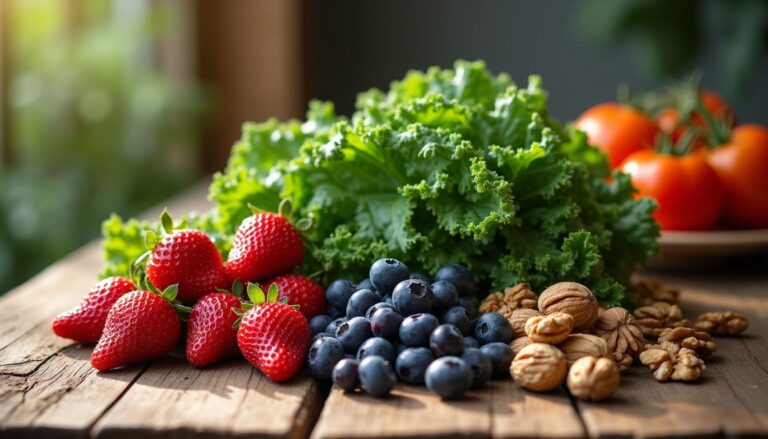Effective Vegetarian Weight Loss Plan: Dietitian-Approved Meal Plan And Food List For Vegan Success
Our Nutrition Assistant AI Suite will transform your body. You will lose fat, get toned, and build muscle. Gain confidence and optimal health.
If you are struggling to lose weight on a vegetarian diet, you are in good company. Cutting meat is a big step, yet progress can stall without a clear meal plan.
Research shows a vegetarian weight loss plan centered on whole foods and plant protein can help you reach a healthy weight while improving heart health¹. In this guide, you get dietitian tips, a simple vegetarian meal plan for weight loss, and a practical food list for vegan and lacto-ovo eaters.
Use these steps to build meals that fit your life, support steady energy, and lead to lasting results.
¹ Source: Harvard T.H. Chan School of Public Health – The Nutrition Source, “Vegetarian Diets.
Key Takeaways
- A vegetarian weight loss plan that favors whole foods and plant proteins may lower heart disease risk by up to 25 percent, reported by Harvard T.H. Chan School of Public Health (2021).
- Dietitians suggest loading up on leafy greens, legumes, and whole grains like quinoa or brown rice. Measure calorie-dense foods such as nuts to manage portions.
- Limit processed vegetarian items, some contain over 800 milligrams of sodium per serving. Reducing refined carbs can cut obesity risk by about 30 percent in studies from 2021.
- Include protein at every meal to aid fullness and metabolism. Top choices are tofu, lentils, chickpeas, tempeh, and Greek yogurt if you eat dairy.
- Plan meals and track intake. Pair smart nutrition with regular activity for safe, long-term results.

Types and Benefits of Vegetarian Diets

Vegetarian diets exclude meat and often poultry and fish. These eating patterns can deliver essential nutrients and may reduce the risk of heart disease.
What are the different types of vegetarian diets?
Lacto-ovo-vegetarians eat eggs and dairy but avoid meat, fish, and poultry. Lacto-vegetarians include dairy products, yet omit eggs and animal flesh. Ovo-vegetarians eat eggs with plant foods such as legumes, vegetables, whole grains, nuts, and seeds, but avoid dairy and meat.
A vegan diet removes all animal products, including honey, milk, yogurt, cheese, eggs, and butter. You rely on fruits, vegetables, beans, lentils, tofu, tempeh, whole-grain bread, pasta, nuts, seeds, and other nutrient-dense foods.
Flexitarians eat mostly vegetarian meals and sometimes add animal products. Pescatarians focus on plants plus fish or seafood, but skip red meat and poultry.
Each style can support a healthy weight when you emphasize fiber-rich choices like leafy greens, mixed vegetables, whole grains, beans, and lentil soups.
A healthy vegetarian meal plan is flexible. You can match the approach to your taste and lifestyle.
What are the nutritional benefits of a vegetarian lifestyle?
Following a vegetarian diet typically means eating more greens, legumes, whole grains, fruits, and vegetables. These foods are high in fiber and rich in vitamins A, C, and E, plus minerals like potassium and magnesium.
Compared with many animal products, vegetarian foods often contain fewer calories and less saturated fat. You can still meet protein needs with tofu, beans, and other plant proteins when you eat a variety of foods.
Large studies link plant-forward eating with lower cholesterol and a reduced risk for cardiovascular disease, sometimes by as much as 25 percent. Higher fiber intake also improves blood sugar control, which may lower diabetes risk.
Many people report steadier energy after switching to whole grains and leafy vegetables. Choosing nutritious options supports weight loss and healthier blood pressure too.
Common Weight Loss Obstacles for Vegetarians
Switching to a vegetarian diet can change your routine, and some choices slow progress. Refined carbs and processed meat alternatives are common pitfalls in a plan for weight loss.
How can portion size and protein intake affect weight loss?
Even healthy vegetarian foods can push you over your calorie target if portions are large. Nuts, seeds, avocado, and oils are nutrient rich and very calorie dense.
For instance, a small handful of almonds packs over 160 calories. Measuring portions helps you enjoy these foods without overshooting your goal.
Protein also matters. It lowers ghrelin, the hunger hormone, and helps you feel full. If meals lack protein from tofu, lentils, edamame, or Greek yogurt, you may feel hungry soon after eating.
Adding an extra half cup of beans at lunch kept me full until dinner,a vegan client told me.
Right-sized portions and enough protein at each meal create steady progress and fewer cravings.
Why should vegetarians limit refined carbohydrates?
Many vegetarian staples are carb heavy. Bread, pizza, and pasta made with white flour are easy to overeat and low in fiber.
Refined grains digest quickly, so you get a short burst of energy followed by hunger. They can spike insulin, which is linked with higher body mass index.
Choose oats, brown rice, and whole grain bread instead. These foods provide fiber, support stable energy, and help you eat fewer calories without feeling deprived.
What are the risks of processed vegetarian products?
Processed vegetarian items, such as veggie burgers, meat analogs, and packaged desserts, often contain a lot of sodium, additives, and added sugars. Some have as many calories as meat-based options.
Frequent use of ultra-processed foods is associated with higher weight gain, elevated blood pressure, and increased LDL cholesterol. One 2021 study linked high intake with a 30 percent rise in obesity risk.
Brands may add refined oils and extra salt to boost taste and shelf life. Even convenient snacks like vegetarian pastries deliver many calories with limited nutrition.
Choosing mostly whole fruits, vegetables, and legumes supports appetite control and nutrient intake. It also makes portion control easier.
Which high-calorie vegetarian foods should be limited?
Whole-food fats are healthy, but portions still count. Nuts, seeds, avocados, and nut butters are calorie dense and easy to overeat.
Two tablespoons of peanut butter have about 190 calories. A few extra scoops or handfuls can stall a calorie deficit.
Plant oils like olive oil add up fast. Cheese-style substitutes made with coconut oil can be high in saturated fat. Measure these foods to stay on track while still getting omega-3 fats from walnuts and chia seeds.
Strategies for Successful Weight Loss with Vegetarian Diets
Success comes from simple habits you repeat. Focus on food quality, steady protein, and smart portions.
How to focus on whole foods and nutrients?
Whole foods give you more nutrients per calorie and make a balanced diet easier. Use this checklist to guide every plate.
- Fill half your plate with non-starchy vegetables such as zucchini, leafy greens, mushrooms, and bell pepper.
- Pick whole grains like quinoa, brown rice, oats, buckwheat, couscous, or barley. Diets high in whole grains may reduce heart disease risk by up to 22 percent.
- Include plant proteins, for example lentils, chickpeas, black beans, tofu, tempeh, edamame, and unsalted nuts.
- Choose unsaturated fats from avocado, olive oil, flaxseed, and chia seeds. These fats support heart health.
- Limit processed vegetarian items such as frozen burgers or salty meat alternatives.
- Swap pastries for fresh fruit to add vitamins and antioxidants linked with lower chronic disease risk.
- If you avoid eggs and dairy, use vitamin B12 fortified foods or talk with a registered dietitian about a supplement. Plants do not supply enough B12.
- Drink water or green smoothies instead of sugary juice or creamy drinks.
- Batch cook legumes and grains. Keep portions ready in the fridge for busy days.
Eating mostly whole foods may reduce long-term disease risk while supporting steady weight loss.
What are effective ways to increase plant-based protein?
Higher protein intake improves fullness and helps protect muscle during dieting. Add protein to every meal and snack.
- Add beans, lentils, and chickpeas to soups, salads, and bowls. A cup of cooked beans can supply up to 15 grams of protein.
- Use soy foods such as tofu, tempeh, and edamame. They are complete proteins, meaning they contain all nine essential amino acids.
- Include nuts and seeds. Most provide 5 to 7 grams of protein per ounce.
- Choose strained yogurt if you eat dairy. Greek yogurt has about 15 to 20 grams per serving.
- Mix grains like quinoa or farro with vegetables. Quinoa offers about 8 grams per cooked cup.
- Try split peas or black-eyed peas. They provide protein and fiber for digestive health.
- Spread protein across the day. This helps stabilize blood sugar and appetite.
- Bake with chickpea flour to boost protein and fiber while lowering refined carbs.
- Combine different plant sources across the day to cover your amino acid needs.
How can portion control aid weight loss?
Portion control helps you eat the right amount without constant calorie counting. Small changes can prevent hundreds of extra calories.
- Use smaller plates and bowls. People often eat 20 percent less with smaller dishware.
- Limit portions of calorie-dense foods like nuts, avocado, pastries, and cheese.
- Measure grains, sauces, and dressings with cups or a kitchen scale.
- Read labels on meat substitutes. Many use oils that raise calories quickly.
- Practice mindful eating. Pause between bites and check if you are satisfied.
- Measure oils and dressings. One tablespoon is plenty for most salads.
- Pre-portion snacks such as cut vegetables, baked chickpeas, or a small handful of nuts.
- Prioritize high-fiber foods. They fill you up faster than refined snacks.
- Track intake with an app or journal to stay accountable to your goals.
Smart portions support a plant-based diet and help prevent obesity and diabetes.
Why reduce sugars and refined carbs in a vegetarian diet?
Sugary foods and refined grains can slow fat loss. They add calories fast and leave you hungry again soon.
- White bread and pasta provide energy but very few nutrients.
- Sugary drinks and sweets spike blood sugar, then lead to energy crashes and cravings.
- High added sugar intake raises the risk of heart disease and type 2 diabetes.
- Many vegetarian convenience foods rely on refined grains that do not support steady energy.
- Complex carbs from whole grains, legumes, fruit, and starchy vegetables keep you satisfied longer.
- Reducing sugar helps shrink waistline fat, which is tied to lower long-term risk.
- Check labels for hidden sugars and refined flours.
- Baked goods and sweetened bars can add hundreds of empty calories each day.
- A whole-food vegetarian diet improves fiber intake and reduces cravings.
- Fewer refined carbs make it easier to maintain a calorie deficit for weight loss.
Choose whole grains over white flour snacks to reach your goals faster.
How do hydration and healthy fats support weight loss?
Water and healthy fats help manage hunger and energy. Both also support nutrient absorption.
- Drink at least 8 cups of water daily. Hydration helps regulate metabolism and can curb false hunger.
- Eat healthy fats like avocado, olive oil, nuts, seeds, and nut butters. They keep you satisfied longer.
- Get omega-3 fatty acids from chia seeds and walnuts. These fats may reduce inflammation.
- Skip sugary drinks. Choose water or unsweetened tea to avoid extra calories.
- Studies show drinking 16 ounces of water can increase calorie burn for about an hour.
- Fats help your body absorb vitamins A, D, E, and K from vegetables.
- Nuts make a better snack than processed sweets. A small handful goes a long way.
- Coconut products contain medium-chain triglycerides; some research links them with a slight rise in energy use.
- Avoid fried foods cooked in low quality oils. They add unhealthy fats that slow progress.
- Proper hydration supports workouts, which helps fat loss and heart health.
Essential Foods for a Vegetarian Weight Loss Diet
Nutrient-dense foods help you feel full on fewer calories. Build your cart around these staples.
What greens and low-starch vegetables are best?
Leafy greens and low-starch vegetables give you volume, fiber, and vitamins at a low calorie cost.
- Broccoli supplies vitamin C, fiber, and a bit of protein. Steam it or add to salads.
- Bell pepper adds color and crunch with vitamin A and antioxidants.
- Cauliflower is low in carbs. Roast it or use it as a pizza crust base.
- Zucchini has very few calories. Spiralize it as a pasta swap.
- Mushrooms bring savory flavor and B vitamins. Sauté for scrambles or soups.
- Tomatoes add lycopene and potassium. Toss into salads or blend into soups.
- Eggplant builds volume with few calories. Grill slices for sandwiches or casseroles.
- Carrots offer beta carotene and fiber. Snack on sticks or grate into veggie burgers.
- Celery hydrates and adds crunch. Pair with a light smear of nut butter.
- Cucumber is over 95 percent water. Add to salads or smoothies for refreshment.
Use several of these vegetables each day to keep meals large, tasty, and satisfying.
Which legumes provide the most protein?
Legumes are stars for protein and fiber. They help control hunger and support muscle health.
- Lentils, about 18 grams per cooked cup. Great in soups or salads.
- Black beans, almost 15 grams per cooked cup. Ideal for tacos and bowls.
- Pinto beans, around 15 grams per cooked cup. Use in stews or spreads.
- Kidney beans, roughly 13 grams per cooked cup. Add to chili or salads.
- Chickpeas, about 14.5 grams per cooked cup. Blend into hummus or roast for snacks.
- Edamame, around 17 grams per cooked cup. Eat from the pod or toss with greens.
- Green peas, nearly 9 grams per cooked cup. Mix into stir-fries and whole grain dishes.
Combining different beans during the week keeps flavors fresh and nutrient intake broad.
What whole grains support weight loss?
Whole grains pair well with beans and vegetables. They add fiber and steady energy.
- Quinoa has about 8 grams of protein per cooked cup and is gluten free.
- Brown rice offers more nutrients than white rice and helps stabilize blood sugar.
- Farro brings fiber and protein. Toss into salads and grain bowls.
- Millet is easy to digest and low in calories per serving.
- Barley contains beta-glucan, a fiber that may reduce appetite and cholesterol.
- Bulgur cooks fast and supplies over 4 grams of fiber per cooked cup.
- Oats provide slow-release energy and can help lower cholesterol.
How do tofu and tempeh fit into a vegetarian diet?
Tofu and tempeh are reliable, lean protein sources. They are versatile and easy to flavor.
- Tofu, made from soybeans, has about 8 grams of protein per 3 ounces.
- Tempeh provides around 16 grams per 3 ounces and also contains fiber, iron, and calcium.
- Both are low in saturated fat and contain essential amino acids that support muscle repair.
- Grill, bake, stir-fry, or blend into sauces for a range of textures.
- Studies cited by the Academy of Nutrition and Dietetics link soy proteins with better muscle retention during weight loss.
- Edamame offers about 11 grams of protein per half cup for quick snacks.
- Add tofu to salads or curries and slice tempeh for sandwiches or bowls.
- Regular soy intake may help lower cholesterol, reported in The Journal of Nutrition in 2021.
Rotate tofu, tempeh, and edamame across the week to meet protein needs with variety.
What are good sources of healthy fats for vegetarians?
Healthy fats support fullness and hormone balance. Choose them in small portions to manage calories.
- Avocados offer monounsaturated fats and a creamy texture.
- Olive oil brings antioxidants. Use as a light dressing or roasting oil.
- Coconut products contain medium-chain triglycerides for variety in recipes.
- Almonds, walnuts, and pistachios supply fiber and omega-3s. Keep to a small handful.
- Chia, flax, sunflower, pumpkin, and hemp seeds add omega-3s and fiber. Sprinkle on cereal or yogurt.
- Peanut and almond butter deliver unsaturated fats. Spread thinly on whole-grain toast.
- Cheese can fit for lacto-ovo eaters, but use modest portions due to calories.
Foods to Minimize for Effective Weight Loss
Some foods make weight control harder. Cutting them back helps you hit your goals faster.
Why avoid processed vegetarian foods?
Many processed vegetarian foods, including meat replacements, frozen meals, and imitation dairy, pack sodium, sugar, and refined oils. A single frozen entrée can exceed 800 milligrams of sodium.
These products are calorie dense and often low in fiber. Weight loss can stall even when total calories look right on paper because fullness is low and portions creep up.
Choosing cooked lentils, beans, and fresh vegetables instead can raise energy levels and improve satiety. Whole foods add nutrients without the extras common in packaged items.
What sugary drinks and desserts should be limited?
Limit sodas, sweet teas, energy drinks, and large fruit juices. One can of soda may carry 35 grams of sugar, which is about nine teaspoons.
Skip frequent desserts such as candy bars, cookies, and pastries. Many single servings top 20 grams of sugar.
Replacing after-dinner sweets with fruit or tea trims calories and helps you reach targets sooner.
How to reduce refined grains in your diet?
Swap white bread, white pasta, bagels, and crackers for whole grain versions. Read labels and look for the word “whole” at the start of the ingredient list.
Cook batches of quinoa, bulgur, or brown rice for easy add-ins. Using these staples at home helps you control the quality of grains in your meals.
What is the impact of high-fat dairy and cheese on weight?
High-fat dairy and cheese are calorie dense. One ounce of cheddar has about 120 calories and 10 grams of fat.
It is easy to exceed a single serving, which can slow progress. Swapping one ounce of regular cheese for a low-fat option each day can cut roughly 700 calories across a week.
Rely more on plant proteins like beans and tofu, and keep cheese portions small if you include dairy.
Week-long Vegetarian Meal Plan for Weight Reduction
A dietitian-approved vegetarian meal plan offers structure. Use these day-by-day ideas to stay on track without overthinking.
What does Day 1’s whole grains and protein meals look like?
Day 1 builds a base with fiber, plant protein, and healthy fats to control hunger.
- Breakfast: strawberry banana green smoothie, 318 calories.
- Lunch: crisp green salad with pita and hummus, 374 calories.
- Dinner: spaghetti squash with roasted tomatoes, beans, and almond pesto, 400 calories.
- Snacks: one large hard-boiled egg, 78 calories, plus one plum, 30 calories.
- Daily total: about 1,200 calories and 52 grams of protein for steady loss.
- Approximate macros: 146 grams carbs, 30 grams fiber, and 1,592 milligrams sodium.
- Many readers find this mix stops cravings thanks to fiber and balanced portions.
Whole foods make the day satisfying without excess calories.
How to combine legumes and greens on Day 2?
Legumes and leafy greens offer protein, iron, and a lot of volume for few calories.
- Add edamame to a Greek-style salad at lunch, about 346 calories.
- Dinner: kale salad with roasted beets and wild rice, about 496 calories.
- Breakfast: egg salad on avocado toast, about 230 calories.
- Snack: whole-wheat toast with sliced avocado, about 78 calories.
- Snack: half cup raspberries, about 32 calories.
- Snack: one hard-boiled egg, about 78 calories.
- Watch sodium. This day can reach about 1,986 milligrams; choose low-sodium options when possible.
- Aim for about 53 grams of protein and roughly 98 grams of carbs.
- Use light portions of nuts and dressings. Fats add up quickly.
- Mix different greens and legumes to vary textures and nutrients.
What are fiber-rich breakfast and low-calorie snack ideas for Day 3?
Fiber at breakfast and simple snacks can hold you over between meals and keep energy stable.
- Breakfast: 1 cup plain nonfat Greek yogurt with 1/4 cup raspberries and 2 tablespoons almonds, about 268 calories.
- Snack: cucumber slices with sherry shallot vinaigrette, about 101 calories.
- Snack: half cup raspberries, about 32 calories.
- Daily totals: 1,200 calories, roughly 60 grams protein, 113 grams carbs, 30 grams fiber, 61 grams fat, and around 1,187 milligrams sodium.
- Use raw or lightly steamed vegetables for extra volume without many calories.
- Pair protein, like yogurt or tofu, with fruit to improve satiety.
- Prepping these snacks ahead of time helps you skip processed choices later.
Simple, high-fiber meals can prevent the afternoon slump and late-night snacking.
Which plant-based proteins and fats are featured on Day 4?
Day 4 spotlights plant proteins with healthy fats for steady energy and fullness.
- Tofu at dinner provides about 8 grams of protein per 3 ounces with fewer than 100 calories.
- Hemp seeds in a smoothie bowl add over 9 grams of protein in 3 tablespoons plus omega-3 and omega-6 fats.
- Unsweetened almond milk keeps calories lower while adding a creamy base.
- Pistachios make a satisfying snack, with about 6 grams of protein per ounce.
- Soy sauce in stir-fry adds flavor. Use a small amount and balance with protein-rich tofu.
- Dried mango pairs with pistachios for quick energy. Keep portions small due to higher calories.
- Brown rice rounds out dinner with fiber and complex carbs for fullness.
What nutrient-dense smoothies and salads suit Day 5?
Day 5 emphasizes smoothies and salads to pack in protein, fiber, and micronutrients with minimal fuss.
- Breakfast smoothie: 1 cup nonfat Greek yogurt, 1/4 cup raspberries, a handful of spinach, and 2 tablespoons almonds, about 252 calories.
- Lunch: lentil and veggie salad with slow-cooker creamy lentil soup. Add sturdy greens for iron and vitamin C.
- Snack: sliced carrots with hummus, about 115 calories.
- Dinner: tofu and vegetable scramble over spring mix or chopped raw vegetables, around 420 calories. Keep total daily fat near 47 grams.
- Snack: 3/4 cup frozen grapes, about 78 calories, for a cool, light finish.
- Top salads with 2 tablespoons toasted nuts or seeds for texture and healthy fats.
- For extra fullness, blend a small portion of cooked lentils into a smoothie.
These meals are easy to prep and keep your plan varied and satisfying.
How to prepare filling soups and stir-fries for Day 6?
Soups and stir-fries create hearty meals without a lot of calories. They also reheat well for busy days.
- Start with squash, bell peppers, carrots, and spinach to build volume and fiber.
- Add red lentils or tofu for protein and texture.
- Use aromatics like garlic, ginger, and onion with spices such as curry powder for flavor without extra calories.
- Simmer squash with red lentils for a creamy curry, about 430 calories per serving.
- Stir in kale or baby spinach at the end to protect nutrients.
- Dress cooked greens with a tablespoon of vinaigrette instead of creamy sauces.
- Snacks: 2 tablespoons almonds, about 103 calories, plus one hard-boiled egg, 78 calories. Day 6 totals about 1,214 calories and 50 grams protein.
- Batch cook and portion into containers for quick lunches.
- Measure oils carefully. Keep to about one tablespoon per recipe.
- Finish with fresh herbs like cilantro or parsley for flavor without sodium.
Prepping a pot of red lentil curry on Sunday can carry you through the week with minimal effort.
What diverse plant-based dishes can be made on Day 7?
Day 7 brings fresh produce, legumes, and healthy fats together for a colorful finish.
- Breakfast: strawberry banana green smoothie, 318 calories, with leafy greens and almond milk.
- Lunch: leftover slow-cooker creamy lentil soup, 320 calories, for sustained energy.
- Dinner: raw vegan zoodles with romesco sauce, 361 calories, plus cannellini beans and mixed greens.
- Snack: two plums, 61 calories, for a sweet, light bite.
- Snack: half cup raspberries with 2 tablespoons almonds, 135 calories, for fiber and healthy fats.
- Daily totals: about 1,195 calories, 60 grams protein, 157 grams carbs, 42 grams fiber, 46 grams fat, and roughly 1,482 milligrams sodium.
- Structured days like this help you hit targets without feeling deprived.
- Focus on beans, berries, leafy greens, nuts, and nutrient-dense vegetables at every meal.
Meal Preparation Techniques for Vegetarians
Meal prep removes guesswork. A few weekly habits can make healthy eating much easier.
How to batch cook grains and legumes efficiently?
Cooking larger batches saves time and ensures protein and fiber are always on hand.
- Plan portions of quinoa, brown rice, lentils, black beans, or chickpeas for the week.
- Rinse under cold water to remove dirt and extra starch.
- Use a large pot or rice cooker to prepare double or triple batches.
- Cook in low-sodium vegetable broth for extra flavor without many calories.
- Time your cooks. Grains often need 30 to 40 minutes; lentils and beans may take 20 to 60.
- Drain legumes, then cool on a tray to prevent mushiness.
- Portion into single-meal containers and label with dates.
- Refrigerate up to five days or freeze for up to three months.
- Roast vegetables during the same session to build mix-and-match meals like roasted vegetable and black bean tacos.
Having ready grains and beans makes it easier to choose balanced meals on busy nights.
What are easy ways to prepare vegetables for the week?
Front-loading prep time boosts your daily veggie intake and cuts cooking stress.
- Wash and dry big batches of spinach, romaine, or kale. Store in airtight containers with paper towels.
- Cut bell peppers, carrots, celery, and cucumbers into snack sticks. Keep them visible in the fridge.
- Roast trays of broccoli, cauliflower, sweet potatoes, or zucchini at 400°F for 25 to 30 minutes.
- Spiralize or dice zucchini and yellow squash for fast stir-fries or noodle swaps.
- Steam green beans, asparagus, or Brussels sprouts until crisp-tender, then chill quickly.
- Keep shredded cabbage ready for crunch in bowls and sandwiches.
- Combine chopped onions, garlic, and shallots for a quick sauté base.
- Bag kale leaves for smoothies to speed up breakfasts.
- Roast grape tomatoes with olive oil and garlic at 400°F for 20 minutes for an easy topping.
- Shred carrots and beets with a grater or food processor for salads and yogurt bowls.
These small steps turn weeknights into simple assemble-and-eat moments.
How to organize meals for convenient weekly consumption?
Organization helps you stay consistent and avoid high-calorie takeout on hectic days.
- Draft a weekly plan listing all breakfasts, lunches, dinners, and snacks.
- Shop with a list based on the plan to reduce waste and impulse buys.
- Cook big batches of staples like lentil soup or brown rice and freeze portions.
- Use stackable, labeled containers for greens, veggie sticks, cooked grains, and proteins.
- Date everything to track freshness.
- Pack extra servings at dinner to create easy lunches for the next day.
- Set aside a weekend hour to wash, chop, and portion vegetables.
- Group similar foods in the fridge so assembly is quick and balanced.
- Rotate frozen meals every few days to keep variety.
- Track intake with a diary or app to align calories with your goals.
This system reduces decision fatigue and helps you stick to your vegetarian plan.
Advantages of a Dietitian-Recommended Vegetarian Weight Loss Regimen
Working with a registered dietitian gives you a clear path. You learn what to eat, how much, and why it works.
What are the long-term benefits of dietitian-approved weight loss?
Reaching a healthy weight lowers the risk of type 2 diabetes and heart disease. The CDC notes that losing just 5 to 10 percent of body weight can improve blood pressure, cholesterol, and blood sugar.
Following safe targets, about 1 to 2 pounds per week, protects muscle while reducing fat. Dietitian guidance also builds lasting habits, from meal planning to label reading.
Over time, you eat more whole grains, vegetables, legumes, and plant proteins, and fewer processed foods. Energy rises, digestion improves, and planning gets easier with practice.
How does this diet lower the risk of lifestyle diseases?
A vegetarian weight loss plan includes whole grains, produce, legumes, and plant proteins. This pattern helps lower cholesterol and blood pressure.
Fiber and antioxidants in plant foods support heart health. The American Heart Association notes vegetarians may have up to a 25 percent lower risk of dying from heart disease.
Higher fiber intake supports better blood sugar control and may prevent type 2 diabetes. Research also links plant-forward eating with a lower risk of some cancers and hypertension.
Reducing saturated fat from animal sources further improves long-term outcomes.
In what ways does it enhance energy and digestive health?
Meals rich in plant protein and fiber digest more slowly. You get steady energy and fewer crashes, which supports exercise and focus.
Most adults need at least 25 grams of fiber per day for women and 38 grams for men. Eating legumes, whole grains, nuts, seeds, and vegetables at each meal helps you meet that goal. Better regularity often shows up within days.
Conclusion
You can achieve healthy weight loss on a vegetarian diet with clear steps and consistent habits. Focus on whole foods, steady protein, and smart portions. Make vegetables, legumes, and lean plant proteins the center of your plate.
Cut back on refined carbs, processed products, and sugary items to protect your calorie deficit. Plan meals ahead, track intake, and move your body most days of the week. These actions support lasting change.
Consider a registered dietitian if you want a personalized plan or have medical conditions. This content is educational and is not a substitute for medical advice. With daily choices that fit your life, you set yourself up for long-term vegan or vegetarian success and better health.
FAQs
1. What is a vegetarian weight loss plan and how does it work for vegan success?
A vegetarian weight loss plan uses plant-based foods to help reduce calorie intake while meeting nutritional needs. Dietitian-approved meal plans focus on whole grains, legumes, fruits, vegetables, nuts, and seeds. Studies show that these foods are high in fiber and low in saturated fat which supports healthy weight management.
2. Which foods should I include or avoid for effective results?
Include lentils, chickpeas, quinoa, brown rice, leafy greens, berries, tofu products like bean curd blocks or soy protein strips; also add almonds and chia seeds for healthy fats. Limit processed snacks such as potato chips or sweetened cereals since they often contain added sugars and unhealthy oils.
3. How can I make sure my vegetarian diet provides enough protein during weight loss?
Choose diverse sources of plant proteins such as beans like black beans or kidney beans; peas; tempeh; seitan made from wheat gluten; nuts including walnuts or cashews; and fortified dairy alternatives like oat milk with added protein. Research shows that combining different types of plant proteins throughout the day helps meet daily amino acid requirements.
4. Are there any risks linked to following a strict vegan meal plan for losing weight?
Some people may face nutrient gaps if they do not eat a variety of foods rich in iron found in spinach leaves or pumpkin seeds; vitamin B12 from supplements since plants do not provide this nutrient naturally; calcium from fortified beverages like almond milk with added minerals; and omega-3s from flaxseed oil instead of fish oil capsules. Careful planning prevents most deficiencies according to registered dietitians who specialize in plant-based nutrition.
Summary: A well-designed vegetarian meal plan supports safe weight loss by focusing on whole food choices backed by research data while avoiding common pitfalls through careful selection of key nutrients.







